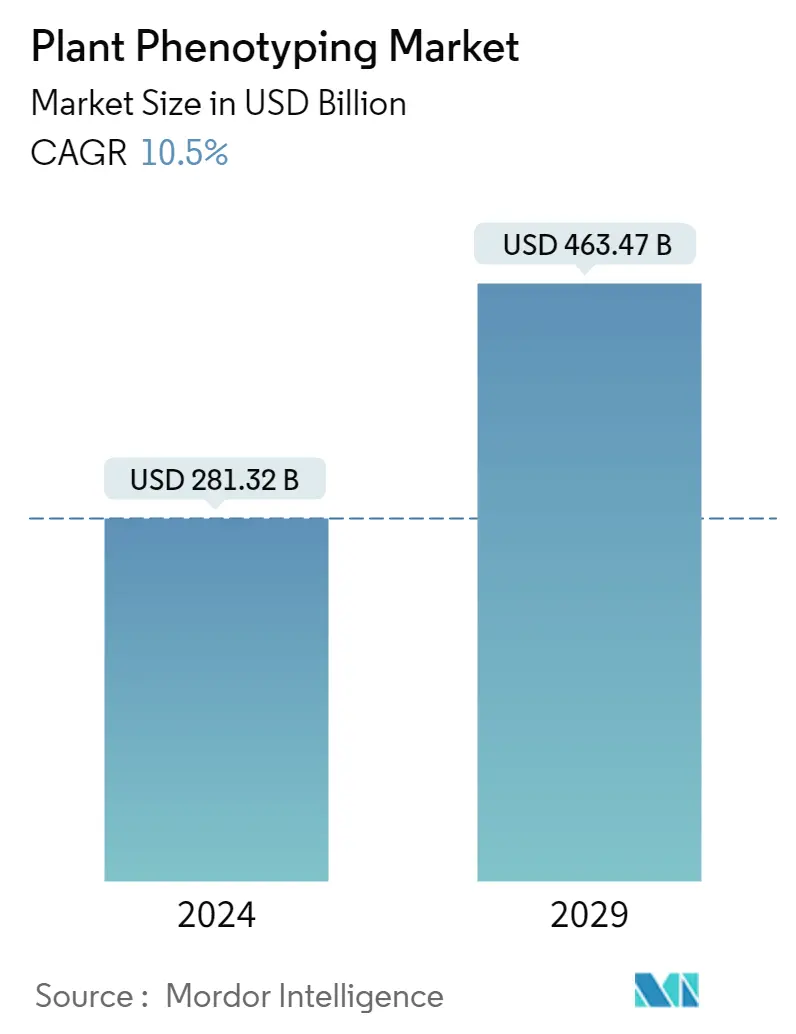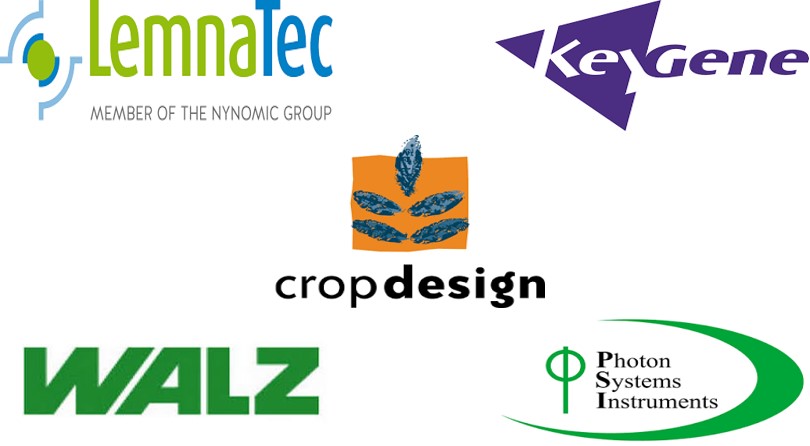
| Study Period | 2019 - 2029 |
| Market Size (2024) | USD 281.32 Billion |
| Market Size (2029) | USD 463.47 Billion |
| CAGR (2024 - 2029) | 10.50 % |
| Fastest Growing Market | Asia Pacific |
| Largest Market | Europe |
| Market Concentration | High |
Major Players
*Disclaimer: Major Players sorted in no particular order |
Plant Phenotyping Market Analysis
The Plant Phenotyping Market size is estimated at USD 281.32 billion in 2024, and is expected to reach USD 463.47 billion by 2029, growing at a CAGR of 10.5% during the forecast period (2024-2029).
The increasing population has driven the need to grow high-yielding crops for the fulfillment of food security needs, which in turn is boosting the demand for innovative plant breeding techniques for improved crop productivity. High frequency of extreme weather conditions and global warming are also enhancing the need for crop productivity across the world which is favoring the phenotyping market. The market is dominated by the European region.
Furthermore, the innovations in imaging techniques facilitate the better assessment of plant characteristics for the development of better crop breeds suitable for the particular environment. Imaging techniques assist in detecting optical properties of plants by using various technologies like imaging spectroscopy, infrared imaging, fluorescence imaging, and visible light imaging, whose, data sorts from macroscopic to molecular scale.
Plant Phenotyping Industry Segmentation
Plant phenotyping is an emerging scientific technique that links genomics with plant agronomy. In the process of phenotyping, the functional plant body or phenotype is formed during plant growth and development from the dynamic interaction between the genetic background or genotype and the physical world in which plants develop or the environment.
A phenotype refers to the composite of an organism’s observable characteristics or traits, such as its morphology, development, biochemical or physiological properties, behavior, and products of behavior. A phenotype is a result produced by the expression of an organism’s genetic code or genotype, as well as the influence of environmental factors and the interactions between the two. The basic use of plant phenotyping is to gain knowledge of various plant attributes and to utilize it for production of crops with higher productivity and sustainability.
| Equipment | By Automation Type | Manual |
| Semi-Automated | ||
| Fully Automated | ||
| Equipment | By Application | High-Throughput Screening |
| Trait Identification | ||
| Photosynthetic Performance | ||
| Morphology and Growth Assessment | ||
| Other Applications | ||
| Equipment | By Analysis System | Image Analysis Systems |
| Multispectral Scientific Cameras | ||
| Canopy Analysis Systems | ||
| Fluorometers | ||
| Others | ||
| Equipment | By Site | Laboatory |
| Green House | ||
| Field | ||
| Equipment | By Platform | Conveyor-Based/Modular Systems |
| Bench-Based Systems | ||
| Handheld/Portable Systems | ||
| Drones | ||
| Softwares | Image Analysis | |
| Data Acquisition | ||
| System Control | ||
| Other Softwares | ||
| Sensors | Image Sensors | |
| NDVI Sensors | ||
| Temperature Sensors | ||
| Other Sensors |
| Measurement Acquisition & Data Analysis |
| Statistical Analysis |
| North America | United States |
| Canada | |
| Mexico | |
| Rest of North America | |
| Europe | Germany |
| United Kingdom | |
| France | |
| Italy | |
| Russia | |
| Spain | |
| Rest of Europe | |
| Asia Pacific | China |
| Japan | |
| India | |
| Australia | |
| Rest of Asia-Pacific | |
| South America | Brazil |
| Argentina | |
| Rest of South America | |
| Africa | South Africa |
| Rest of Africa |
Plant Phenotyping Market Size Summary
The plant phenotyping market is experiencing significant growth, driven by the increasing global population and the subsequent demand for high-yielding crops to ensure food security. This demand is further amplified by the challenges posed by extreme weather conditions and global warming, which necessitate improved crop productivity. The market is predominantly led by Europe, where innovations in imaging techniques are enhancing the assessment of plant characteristics, thereby facilitating the development of crop breeds tailored to specific environments. These techniques, which include imaging spectroscopy, infrared imaging, fluorescence imaging, and visible light imaging, are crucial for detecting the optical properties of plants at various scales. The need to combat seed-transmitted plant diseases is also propelling the market, as these diseases can significantly impact crop productivity.
The European region holds a dominant position in the plant phenotyping market, supported by substantial funding from governments and organizations, as well as the presence of key industry players. This region benefits from a robust research environment, particularly in Mediterranean countries, where unique climatic conditions drive agricultural production and breeding initiatives. The market is characterized by intense competition, with major players like LemnaTec, CropDesign - BASF SE, Heinz Walz, Photon Systems Instruments, Qubit Systems, and KeyGene leading the charge. These companies are actively investing in product launches, mergers, acquisitions, collaborations, and expansions to maintain their competitive edge. Notable developments include BASF's establishment of a global breeding center for cucumbers, which integrates advanced phenotyping lines for digital fruit evaluation, and the development of novel sensors for monitoring plant growth and soil quality.
Plant Phenotyping Market Size - Table of Contents
1. MARKET DYNAMICS
- 1.1 Market Overview
- 1.2 Market Drivers
- 1.3 Market Restraints
-
1.4 Porter's Five Force Analysis
- 1.4.1 Threat of New Entrants
- 1.4.2 Bargaining Power of Buyers
- 1.4.3 Bargaining Power of Suppliers
- 1.4.4 Threat of Substitute Products
- 1.4.5 Competitive Rivalry
2. MARKET SEGMENTATION
-
2.1 Products
- 2.1.1 Equipment
- 2.1.1.1 By Automation Type
- 2.1.1.1.1 Manual
- 2.1.1.1.2 Semi-Automated
- 2.1.1.1.3 Fully Automated
- 2.1.1.2 By Application
- 2.1.1.2.1 High-Throughput Screening
- 2.1.1.2.2 Trait Identification
- 2.1.1.2.3 Photosynthetic Performance
- 2.1.1.2.4 Morphology and Growth Assessment
- 2.1.1.2.5 Other Applications
- 2.1.1.3 By Analysis System
- 2.1.1.3.1 Image Analysis Systems
- 2.1.1.3.2 Multispectral Scientific Cameras
- 2.1.1.3.3 Canopy Analysis Systems
- 2.1.1.3.4 Fluorometers
- 2.1.1.3.5 Others
- 2.1.1.4 By Site
- 2.1.1.4.1 Laboatory
- 2.1.1.4.2 Green House
- 2.1.1.4.3 Field
- 2.1.1.5 By Platform
- 2.1.1.5.1 Conveyor-Based/Modular Systems
- 2.1.1.5.2 Bench-Based Systems
- 2.1.1.5.3 Handheld/Portable Systems
- 2.1.1.5.4 Drones
- 2.1.2 Softwares
- 2.1.2.1 Image Analysis
- 2.1.2.2 Data Acquisition
- 2.1.2.3 System Control
- 2.1.2.4 Other Softwares
- 2.1.3 Sensors
- 2.1.3.1 Image Sensors
- 2.1.3.2 NDVI Sensors
- 2.1.3.3 Temperature Sensors
- 2.1.3.4 Other Sensors
-
2.2 Services
- 2.2.1 Measurement Acquisition & Data Analysis
- 2.2.2 Statistical Analysis
-
2.3 Geography
- 2.3.1 North America
- 2.3.1.1 United States
- 2.3.1.2 Canada
- 2.3.1.3 Mexico
- 2.3.1.4 Rest of North America
- 2.3.2 Europe
- 2.3.2.1 Germany
- 2.3.2.2 United Kingdom
- 2.3.2.3 France
- 2.3.2.4 Italy
- 2.3.2.5 Russia
- 2.3.2.6 Spain
- 2.3.2.7 Rest of Europe
- 2.3.3 Asia Pacific
- 2.3.3.1 China
- 2.3.3.2 Japan
- 2.3.3.3 India
- 2.3.3.4 Australia
- 2.3.3.5 Rest of Asia-Pacific
- 2.3.4 South America
- 2.3.4.1 Brazil
- 2.3.4.2 Argentina
- 2.3.4.3 Rest of South America
- 2.3.5 Africa
- 2.3.5.1 South Africa
- 2.3.5.2 Rest of Africa
Plant Phenotyping Market Research FAQs
How big is the Plant Phenotyping Market?
The Plant Phenotyping Market size is expected to reach USD 281.32 billion in 2024 and grow at a CAGR of 10.5% to reach USD 463.47 billion by 2029.
What is the current Plant Phenotyping Market size?
In 2024, the Plant Phenotyping Market size is expected to reach USD 281.32 billion.


